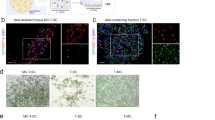Abstract
We evaluated the efficiency of transfecting adenoviral vectors encoding enhanced green fluorescent protein (AdCMV-EGFP) into rat submandibular gland cells and the effects of gene transfer on cell proliferation and secretory function. Isolated submandibular gland cells were transfected with different titers (or multiplicity of infection, MOI) of AdCMV-EGFP. The transfection efficiency was evaluated by quantifying EGFP-positive cells by inverted fluorescence microscopy, cell proliferation by MTT assay, and cell secretory activity by measuring α-amylase in culture medium. A transfection efficiency of up to 70.8 % was achieved in submandibular gland cells. MTT assay showed that increased viral titers resulted in significant inhibition of cell proliferation, which occurs on day 5 post-transfection. Simultaneously, the amylase levels started to reduce with a significant decrease on day 7 after transfection. The results show that AdCMV-EGFP transfection of submandibular gland cells at higher MOI results in cytotoxicity, decreased cell proliferation, and secretory function. However, the lower adenoviral titers (e.g., 200 particles/cell) could be an efficient and safe labeling tool for gene transfer to submandibular gland cells.








Similar content being viewed by others
References
Misra, S. (2013). Human gene therapy: A brief overview of the genetic revolution. Journal of the Association of Physicians of India, 61(2), 127–133.
Yang, J., Liu, H., & Zhang, X. (2014). Design, preparation and application of nucleic acid delivery carriers. Biotechnology Advances, 32(4), 804–817.
Katz, M. G., Fargnoli, A. S., Williams, R. D., et al. (2013). Gene therapy delivery systems for enhancing viral and nonviral vectors for cardiac diseases: Current concepts and future applications. Human Gene Therapy, 24(11), 914–927.
Kay, M. A. (2011). State-of-the-art gene-based therapies: The road ahead. Nature Reviews Genetics, 12(5), 316–328.
Parhiz, H., Shier, W. T., & Ramezani, M. (2013). From rationally designed polymeric and peptidic systems to sophisticated gene delivery nano-vectors. International Journal of Pharmaceutics, 457(1), 237–259.
Yao, J., Fan, Y., Li, Y., et al. (2013). Strategies on the nuclear-targeted delivery of genes. Journal of Drug Targeting, 21(10), 926–939.
Mohit, E., & Rafati, S. (2013). Biological delivery approaches for gene therapy: Strategies to potentiate efficacy and enhance specificity. Molecular Immunology, 56(4), 599–611.
Kaufmann, K. B., Büning, H., Galy, A., et al. (2013). Gene therapy on the move. EMBO Molecular Medicine, 5(11), 1642–1661.
Herzog, R. W., Cao, O., & Srivastava, A. (2010). Two decades of clinical gene therapy–success is finally mounting. Discovery Medicine, 9(45), 105–111.
Baum, B. J., & O’Connell, B. C. (1995). The impact of gene therapy on dentistry. Journal of the American Dental Association, 126(2), 179–189.
Baum, B. J., & O’Connell, B. C. (1999). In vivo gene transfer to salivary glands. Critical Reviews in Oral Biology and Medicine, 10(3), 276–283.
Hoque, A. T., Yamano, S., Baccaglini, L., et al. (2001). Using salivary glands as a tissue target for gene therapeutics. Journal of Drug Targeting, 9(6), 485–494.
Vitolo, J. M., & Baum, B. J. (2002). The use of gene transfer for the protection and repair of salivary glands. Oral Diseases, 8(4), 183–191.
Kasala, D., Choi, J. W., Kim, S. W., et al. (2014). Utilizing adenovirus vectors for gene delivery in cancer. Expert Opinion on Drug Delivery, 11(3), 379–392.
Wang, D., Zhong, L., Nahid, M. A., et al. (2014). The potential of adeno-associated viral vectors for gene delivery to muscle tissue. Expert Opinion on Drug Delivery, 11(3), 345–364.
Skubis-Zegadło, J., Stachurska, A., & Małecki, M. (2013). Vectrology of adeno-associated viruses (AAV). Medycyna wieku rozwojowego, 17(3), 202–206.
Olszko, M. E., & Trobridge, G. D. (2013). Foamy virus vectors for HIV gene therapy. Viruses, 5(10), 2585–2600.
Khan, K. H. (2013). Gene expression in mammalian cells and its applications. Advanced Pharmaceutical Bulletin, 3(2), 257–263.
Jiang, T., **ng, B., & Rao, J. (2008). Recent developments of biological reporter technology for detecting gene expression. Biotechnology and Genetic Engineering Reviews, 25, 41–75.
Kang, J. H., & Chung, J. K. (2008). Molecular-genetic imaging based on reporter gene expression. Journal of Nuclear Medicine, 49(Suppl 2), 164S–179S.
Tsien, R. (1998). The green fluorescent protein. Annual Review of Biochemistry, 67, 509–544.
Chudakov, D. M., Matz, M. V., Lukyanov, S., et al. (2010). Fluorescent proteins and their applications in imaging living cells and tissues. Physiological Reviews, 90(3), 1103–1163.
Wiedenmann, J., Oswald, F., & Nienhaus, G. U. (2009). Fluorescent proteins for live cell imaging: opportunities, limitations, and challenges. IUBMB Life, 61(11), 1029–1042.
Cormack, B. P., Valdivia, R. H., & Falkow, S. (1996). FACS-optimized mutants of the green fluorescent protein (GFP). Gene, 173(1), 33–38.
Stephens, D., & Allan, V. (2003). Light microscopy techniques for live cell imaging. Science, 300(5616), 82–86.
Koizumi, M., Ito, D., Fujimoto, K., et al. (2004). Conditional transformation of mouse pancreatic epithelial cells: an in vitro model for analysis of genetic events in pancreatocarcinogenesis. Biochemical and Biophysical Research Communications, 319(2), 612–621.
Acknowledgments
This work was supported by Grants from the National Natural Science Foundation (No:81271155, 30830108, 81300852), Jiangsu Province Natural Science Foundation of China (BK20130079), Key Project of Science and Technology Bureau of Jiangsu Province(No.BL2013002), the Youth Start Fund of Nan**g City, (No. 2011-19-198*), and The Third Level Fund for the Young Talents in the Health Field of Nan**g City.
Author information
Authors and Affiliations
Corresponding authors
Additional information
Chao Liu and Leiying Miao have contributed equally to this work.
Rights and permissions
About this article
Cite this article
Liu, C., Miao, L., Sun, W. et al. Assessment of Transfection of AdCMV-EGFP to Rat Submandibular Gland Cells. Cell Biochem Biophys 71, 147–153 (2015). https://doi.org/10.1007/s12013-014-0177-0
Published:
Issue Date:
DOI: https://doi.org/10.1007/s12013-014-0177-0




